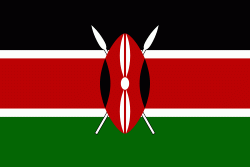Garissa District (Garissa)
Garissa County is an administrative county in Kenya. Its capital and largest urban area is Garissa. The county had a population of 841,353 at the 2019 Census, and a land area of about 44753 km2.
Garissa county has a total population of 841,353 persons of which 458,975 are males, 382,344 females and 34 intersex person. There is a total of 141,394 household with an average size of 5.9 persons per house hold. It has a population density of 19 persons per square kilometre.
Distribution of Population, Land Area and Population Density by County Source
Garissa county has a total population of 841,353 persons of which 458,975 are males, 382,344 females and 34 intersex person. There is a total of 141,394 household with an average size of 5.9 persons per house hold. It has a population density of 19 persons per square kilometre.
Distribution of Population, Land Area and Population Density by County Source
Map - Garissa District (Garissa)
Map
Country - Kenya
 |
 |
| Flag of Kenya | |
Kenya's earliest inhabitants were hunter-gatherers, like the present-day Hadza people. According to archaeological dating of associated artifacts and skeletal material, Cushitic speakers first settled in Kenya's lowlands between 3,200 and 1,300 BC, a phase known as the Lowland Savanna Pastoral Neolithic. Nilotic-speaking pastoralists (ancestral to Kenya's Nilotic speakers) began migrating from present-day South Sudan into Kenya around 500 BC. Bantu people settled at the coast and the interior between 250 BC and 500 AD. European contact began in 1500 AD with the Portuguese Empire, and effective colonisation of Kenya began in the 19th century during the European exploration of the interior. Modern-day Kenya emerged from a protectorate established by the British Empire in 1895 and the subsequent Kenya Colony, which began in 1920. Numerous disputes between the UK and the colony led to the Mau Mau revolution, which began in 1952, and the declaration of independence in 1963. After independence, Kenya remained a member of the Commonwealth of Nations. The current constitution was adopted in 2010 and replaced the 1963 independence constitution.
Currency / Language
| ISO | Currency | Symbol | Significant figures |
|---|---|---|---|
| KES | Kenyan shilling | Sh | 2 |
| ISO | Language |
|---|---|
| EN | English language |
| SW | Swahili language |















